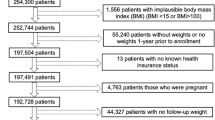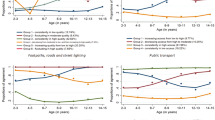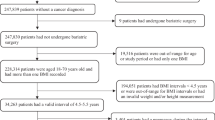Abstract
Objective
To determine whether selected features of the built environment can predict weight gain in a large longitudinal cohort of adults.
Methods
Weight trajectories over a 5-year period were obtained from electronic health records for 115,260 insured patients aged 18–64 years in the Kaiser Permanente Washington health care system. Home addresses were geocoded using ArcGIS. Built environment variables were population, residential unit, and road intersection densities captured using Euclidean-based SmartMaps at 800-m buffers. Counts of area supermarkets and fast food restaurants were obtained using network-based SmartMaps at 1600, and 5000-m buffers. Property values were a measure of socioeconomic status. Linear mixed effects models tested whether built environment variables at baseline were associated with long-term weight gain, adjusting for sex, age, race/ethnicity, Medicaid insurance, body weight, and residential property values.
Results
Built environment variables at baseline were associated with differences in baseline obesity prevalence and body mass index but had limited impact on weight trajectories. Mean weight gain for the full cohort was 0.06 kg at 1 year (95% CI: 0.03, 0.10); 0.64 kg at 3 years (95% CI: 0.59, 0.68), and 0.95 kg at 5 years (95% CI: 0.90, 1.00). In adjusted regression models, the top tertile of density metrics and frequency counts were associated with lower weight gain at 5-years follow-up compared to the bottom tertiles, though the mean differences in weight change for each follow-up year (1, 3, and 5) did not exceed 0.5 kg.
Conclusions
Built environment variables that were associated with higher obesity prevalence at baseline had limited independent obesogenic power with respect to weight gain over time. Residential unit density had the strongest negative association with weight gain. Future work on the influence of built environment variables on health should also examine social context, including residential segregation and residential mobility.
This is a preview of subscription content, access via your institution
Access options
Subscribe to this journal
Receive 12 print issues and online access
$259.00 per year
only $21.58 per issue
Buy this article
- Purchase on SpringerLink
- Instant access to full article PDF
Prices may be subject to local taxes which are calculated during checkout


Similar content being viewed by others
References
Drewnowski A, Buszkiewicz J, Aggarwal A, Rose C, Gupta S, Bradshaw A. Obesity and the built environment: a reappraisal. Obesity. 2020;28:22–30.
Parise I. The built environment and obesity: you are where you live. Aust J Gen Pract. 2020;49:226–30.
Congdon P. Obesity and urban environments. Int J Environ Res Public Health. 2019;16:464. https://doi.org/10.3390/ijerph16030464.
Garfinkel-Castro A, Kim K, Hamidi S, Ewing R. Obesity and the built environment at different urban scales: examining the literature. Nutr Rev. 2017;75:51–61.
Wilkins E, Radley D, Morris M, Hobbs M, Christensen A, Marwa WL, et al. A systematic review employing the GeoFERN framework to examine methods, reporting quality and associations between the retail food environment and obesity. Health Place. 2019;57:186–99. https://doi.org/10.1016/j.healthplace.2019.02.007.
Mooney SJ, Hurvitz PM, Moudon AV, Zhou C, Dalmat R, Saelens BE. Residential neighborhood features associated with objectively measured walking near home: revisiting walkability using the Automatic Context Measurement Tool (ACMT). Health Place. 2020;63. https://doi.org/10.1016/j.healthplace.2020.102332. Published online ahead of print.
Smith M, Hosking J, Woodward A, Witten K, MacMillan A, Field A, et al. Systematic literature review of built environment effects on physical activity and active transport-an update and new findings on health equity. Int J Behav Nutr Phys Act. 2017;14:158. https://doi.org/10.1186/s12966-017-0613-9.
Lake A, Townshend T, Burgoine T, Buttriss J, Welch A, Kearney J, et al. Obesogenic neighbourhood food environments. In: Buttriss J, Welch A, Kearney JM, Lanham-New SA, editors. Public Health Nutrition (The Nutrition Society Textbook) 2nd edn. Wiley-Blackwell, 2017. p. 327–38.
Devarajan R, Prabhakaran D, Goenka S. Built environment for physical activity—an urban barometer, surveillance, and monitoring. Obes Rev. 2020;21. https://doi.org/10.1111/obr.12938. Published online ahead of print.
McCormack G, Blackstaffe A, Nettel-Aguirre A, Csizmadi I, Sandalack B, Uribe F, et al. The Independent Associations between Walk Score® and Neighborhood Socioeconomic Status, Waist Circumference, Waist-To-Hip Ratio and Body Mass Index Among Urban Adults. Int J Environ Res Public Health. 2018;15:1226.
Kowaleski-Jones L, Zick C, Smith KR, Brown B, Hanson H, Fan J. Walkable neighborhoods and obesity: Evaluating effects with a propensity score approach. SSM Popul Health. 2018;6:9–15.
Hobbs M, Griffiths C, Green MA, Jordan H, Saunders J, McKenna J. Neighbourhood typologies and associations with body mass index and obesity: a cross-sectional study. Prev Med (Baltim). 2018;111:351–7.
Salvo G, Lashewicz B, Doyle-Baker P, McCormack G. Neighbourhood built environment influences on physical activity among adults: a systematized review of qualitative evidence. Int J Environ Res Public Health. 2018;15:897.
Bancroft C, Joshi S, Rundle A, Hutson M, Chong C, Weiss CC, et al. Association of proximity and density of parks and objectively measured physical activity in the United States: a systematic review. Soc. Sci. Med.2015;138:22–30.
Kaczynski AT, Besenyi GM, Stanis SWA, Koohsari MJ, Oestman KB, Bergstrom R, et al. Are park proximity and park features related to park use and park-based physical activity among adults? Variations by multiple socio-demographic characteristics. Int J Behav Nutr Phys Act. 2014;11:1–14.
Kaczynski AT, Koohsari MJ, Stanis SAW, Bergstrom R, Sugiyama T. Association of street connectivity and road traffic speed with park usage and park-based physical activity. Am J Health Promot. 2014;28:197–203.
Drewnowski A, Aggarwal A, Tang W, Moudon A. Residential property values predict prevalent obesity but do not predict 1‐year weight change. Obesity. 2015;23:671–6.
Powell-Wiley T, Moore K, Allen N, Block R, Evenson K, Mujahid M, et al. Associations of Neighborhood Crime and Safety and With Changes in Body Mass Index and Waist Circumference: The Multi-Ethnic Study of Atherosclerosis. Am J Epidemiol. 2017;186:280–8.
Leonard T, Ayers C, Das SR, Neeland IJ, Powell-Wiley TM. Do neighborhoods matter differently for movers and non-movers? Analysis of weight gain in the longitudinal Dallas Heart Study. Health Place. 2017;44:52–60.
Ou S. Are some neighborhoods bad for your waistline? A test of neighborhood exposure effects on BMI. J Health Econ. 2019;63:52–63.
Okuyama K, Li X, Abe T, Hamano T, Franks PW, Nabika T, et al. Fast food outlets, physical activity facilities, and obesity among adults: a nationwide longitudinal study from Sweden. Int J Obes. 2020;44:1703–11. https://doi.org/10.1038/s41366-020-0588-5.
Mooney SJ, Bobb JF, Hurvitz PM, Anau J, Theis MK, Drewnowski A, et al. Impact of Built Environments on Body Weight (the Moving to Health Study): Protocol for a Retrospective Longitudinal Observational Study. JMIR Res Protoc. 2020;9:e16787.
Drewnowski A, Arterburn D, Zane J, Aggarwal A, Gupta S, Hurvitz PM, et al. The Moving to Health (M2H) approach to natural experiment research: a paradigm shift for studies on built environment and health. SSM Popul Health. 2019;7:100345.
ESRI. ArcGIS Desktop: Release 10. Redlands, CA: Environmental Systems Research Institute; 2011.
Hurvitz PM, Moudon AV, Kang B, Saelens BE, Duncan GE. Emerging technologies for assessing Physical activity behaviors in space and time. Front Public Health. 2014;2:2.
Pouliou T, Elliott SJ. Individual and socio-environmental determinants of overweight and obesity in Urban Canada. Health Place. 2010;16:389–98.
Huang R, Moudon AVA, Cook AJ, Drewnowski A. The spatial clustering of obesity: does the built environment matter? J Hum Nutr Diet. 2015;28:604–12. https://doi.org/10.1111/jhn.12279.
Sarkar C, Webster C, Gallacher J. Association between adiposity outcomes and residential density: a full-data, cross-sectional analysis of 419 562 UK Biobank adult participants. Lancet Planet Health. 2017;1:e277–88.
Lopez RP. Neighborhood risk factors for obesity. Obesity. 2007;15:2111–9.
Lovasi GS, Neckerman KM, Quinn JW, Weiss CC, Rundle A. Effect of individual or neighborhood disadvantage on the association between neighborhood walkability and body mass index. Am J Public Health. 2009;99:279–84.
Rundle A, Field S, Park Y, Freeman L, Weiss CC, Neckerman K. Personal and neighborhood socioeconomic status and indices of neighborhood walk-ability predict body mass index in New York City. Soc Sci Med. 2008;67:1951–8.
Durand CP, Oluyomi AO, Gabriel KP, Salvo D, Sener IN, Hoelscher DM, et al. The effect of light rail transit on physical activity: design and methods of the travel-related activity in neighborhoods study. Front Public Health. 2016;4:103.
Lovasi GS, Grady S, Rundle A. Steps forward: review and recommendations for research on walkability, physical activity and cardiovascular health. Public Health Rev. 2011;33:484–506.
Vernez Moudon A, Drewnowski A, Duncan GE, Hurvitz PM, Saelens BE, Scharnhorst E. Characterizing the food environment: pitfalls and future directions. Public Health Nutr. 2013;16:1238–43.
Pushkarev B, Zupan J. Public transportation and land use policy. Bloomington: Indiana University Press; 1977.
Frank LD, Pivo G. Impacts of mixed use and density on utilization of three modes of travel: single-occupant vehicle, transit, and walking. Transp Res Rec. 1994;1466:44–52.
Casey JA, Schwartz BS, Stewart WF, Adler NE. Using Electronic Health Records for Population Health Research: a review of methods and applications. Annu Rev Public Health. 2016;37:61–81.
Hurvitz PM, Moudon AV. Home versus nonhome neighborhood: quantifying differences in exposure to the built environment. Am J Prev Med. 2012;42:411–7.
Lee C, Moudon AV, Courbois JYP. Built environment and behavior: spatial sampling using parcel data. Ann Epidemiol. 2006;16:387–94.
Lamb KE, White SR. Categorisation of built environment characteristics: the trouble with tertiles. Int J Behav Nutr Phys Act. 2015;12:1–8.
Mayne SL, Auchincloss AH, Michael YL. Impact of policy and built environment changes on obesity-related outcomes: A systematic review of naturally occurring experiments. Obes Rev. 2015;16:362–75.
Townshend T, Lake A. Obesogenic environments: current evidence of the built and food environments. Perspect. Public Health. 2016;137:38–44. https://doi.org/10.1177/1757913916679860.
Caspi CE, Sorensen G, Subramanian SVVS, Kawachi I. The local food environment and diet: a systematic review. Health Place. 2012;18:1172–87.
Rundle AG, Chen Y, Quinn JW, Rahai N, Bartley K, Mooney SJ, et al. Development of a Neighborhood Walkability Index for Studying Neighborhood Physical Activity Contexts in Communities across the U.S. over the Past Three Decades. J Urban Health. 2019;96:583–90.
Morgan Hughey S, Kaczynski AT, Porter DE, Hibbert J, Turner-McGrievy G, Liu J. Development and testing of a multicomponent obesogenic built environment measure for youth using kernel density estimations. Health Place. 2019;56:174–83.
Martínez-García Trescastro-López, Galiana-Sánchez Pereyra-Zamora. Data collection instruments for obesogenic environments in adults: a scoping review. Int J Environ Res Public Health. 2019;16:1414.
Barquera S, Hernández-Barrera L, Rothenberg SJ, Cifuentes E. The obesogenic environment around elementary schools: food and beverage marketing to children in two Mexican cities. BMC Public Health. 2018;18:1–9.
Jones A, Bentham G, Foster C, MH, Panter J. Tackling obesities: future choices-obesogenic environments-evidence review. London; 2007. https://www.researchgate.net/profile/Andy-Jones-16/publication/252029378_Tackling_Obesities_Future_Choices_-_Obesogenic_Environments_-_Evidence_Review/links/00463539592c87995b000000/Tackling-Obesities-Future-Choices-Obesogenic-Environments-Evidence-Review.pdf.
Bader MDM, Schwartz-Soicher O, Jack D, Weiss CC, Richards CA, Quinn JW, et al. More neighborhood retail associated with lower obesity among New York City public high school students. Health Place. 2013;23:104–10.
Sharp L, Macrorie R, Turner A. Resource efficiency and the imagined public: Insights from cultural theory. Glob Environ Change. 2015;34:196–206.
Chaix B. Mobile sensing in environmental health and neighborhood research. Annu Rev Public Health. 2018;39:367–84.
Kestens Y, Thierry B, Shareck M, Steinmetz-Wood M, Chaix B. Integrating activity spaces in health research: Comparing the VERITAS activity space questionnaire with 7-day GPS tracking and prompted recall. Spat Spatiotemporal Epidemiol. 2018;25:1–9.
An R, Sturm R. School and residential neighborhood food environment and diet among California youth. Am J Prev Med. 2012;42:129–35.
McClure E, Feinstein L, Cordoba E, Douglas C, Emch M, Robinson W, et al. The legacy of redlining in the effect of foreclosures on Detroit residents’ self-rated health. Health Place. 2019;55:9–19.
Bailey ZD, Krieger N, Agénor M, Graves J, Linos N, Bassett MT. Structural racism and health inequities in the USA: evidence and interventions. Lancet. 2017;389:1453–63. https://doi.org/10.1016/S0140-6736(17)30569-X.
Jacoby SF, Dong B, Beard JH, Wiebe DJ, Morrison CN. The enduring impact of historical and structural racism on urban violence in Philadelphia. Soc Sci Med. 2018;199:87–95.
Drewnowski A, Aggarwal A, Cook A, Stewart O, Moudon AV. Geographic disparities in Healthy Eating Index scores (HEI-2005 and 2010) by residential property values: Findings from Seattle Obesity Study (SOS). Prev Med (Baltim). 2016;83:46–55.
Drewnowski A, Aggarwal A, Rehm C. Environments perceived as obesogenic have lower residential property values. Am J Prev Med. 2014;47:260–74.
Funding
This manuscript was supported by three grants from the National Institutes of Health: 1 R01 DK 114196, 5 R01 DK076608, and 4 R00LM012868.
Author information
Authors and Affiliations
Corresponding author
Ethics declarations
Conflict of interest
AD has received grants, honoraria, and consulting fees from numerous food, beverage, and ingredient companies and from other commercial and nonprofit entities with an interest in diet quality and nutrient density of foods. The University of Washington receives research funding from public and private sectors. The remaining authors declare no competing interests.
Additional information
Publisher’s note Springer Nature remains neutral with regard to jurisdictional claims in published maps and institutional affiliations.
Supplementary information
Rights and permissions
About this article
Cite this article
Buszkiewicz, J.H., Bobb, J.F., Hurvitz, P.M. et al. Does the built environment have independent obesogenic power? Urban form and trajectories of weight gain. Int J Obes 45, 1914–1924 (2021). https://doi.org/10.1038/s41366-021-00836-z
Received:
Accepted:
Published:
Issue date:
DOI: https://doi.org/10.1038/s41366-021-00836-z
This article is cited by
-
Impact of the Neighborhood Food Environment on Dietary Intake and Obesity: a Review of the Recent Literature
Current Diabetes Reports (2023)
-
Differential associations of the built environment on weight gain by sex and race/ethnicity but not age
International Journal of Obesity (2021)



